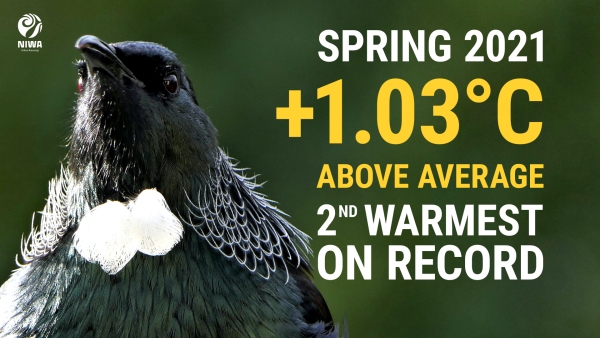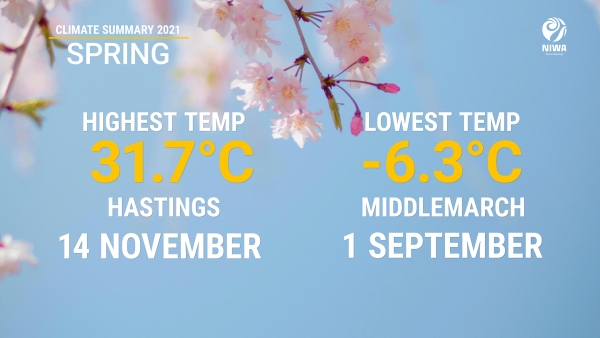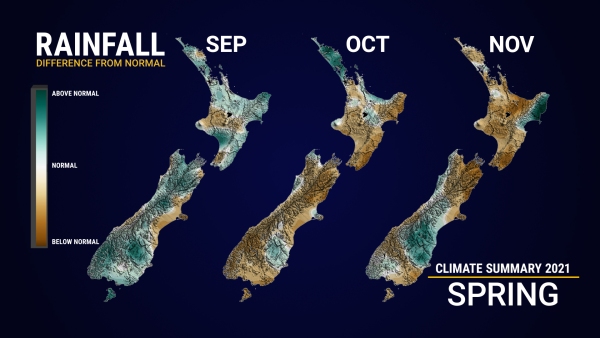New Zealand’s second-warmest spring on record
|
Temperature |
Spring 2021 was the second warmest spring on record in Aotearoa New Zealand. Temperatures were above average (+0.51°C to +1.20°C of average) across nearly all of the North Island and a majority of the South Island. Pockets of well above average temperatures (>1.20°C above average) were recorded in the Bay of Plenty. Near average temperatures (±0.50°C of average) were recorded in northern Tasman, parts of Marlborough, much of coastal Canterbury, and parts of Otago. |
|
Rainfall |
Above normal rainfall (120-149% of normal) was observed in much of Northland, northern Auckland, Gisborne and northern Hawke’s Bay, northern Tasman and interior Otago. Spring rainfall was below normal (50-79% of normal) in parts of Wellington-Wairarapa, eastern Marlborough, and coastal northern and central Canterbury. Near normal (80-119% of normal) rainfall was observed elsewhere. |
|
Soil moisture |
At the end of November, soil moisture levels were below normal across northern Waikato, Bay of Plenty, most of the Central Plateau, northern Manawatū-Whanganui, Wairarapa, Nelson, Marlborough, northern and central Canterbury, and the lower West Coast. Soil moisture levels were above normal in a portion of the Far North, coastal Gisborne, interior southern Canterbury, and interior Southland. Elsewhere, soil moisture levels were near normal. |
Overview
In typical spring fashion, the season as a whole featured variable weather patterns. Extended periods of settled weather were interrupted by active weather and extreme events. Developing La Niña conditions resulted in a transition from a westerly air flow, near average temperatures and widespread wet weather during September to more northerly and north-easterly winds during October and November, bringing frequent warm and humid weather and contributing to what was the country’s 5th-warmest October and warmest November on record.
For spring as a whole, the nationwide average temperature was 13.1°C (1.0°C above the 1981-2010 average from NIWA’s seven station temperature series which begins in 1909), making spring 2021 the second warmest spring on record. The warmest spring on record occurred in 1988. Many locations experienced record or near-record high mean temperatures for the season while no locations observed record or near-record low mean temperatures. The Southern Annular Mode (SAM) was predominantly positive during spring, which favoured higher than normal air pressure in the New Zealand region. In fact, the SAM was exclusively in its positive phase for the entirety of September and November. The warmth was also helped along by the aforementioned change to more northerly quarter (sub-tropical) wind flows from October onwards, frequently bringing warm and humid weather. Moreover, warm coastal sea surface temperatures (particularly in November when marine heatwave conditions emerged) influenced temperatures on land. This is in addition to a generally warmer background state due to our warming climate.
Spring rainfall was below normal (50-79% of normal) in parts of Wellington-Wairarapa, eastern Marlborough, and coastal northern and central Canterbury while above normal rainfall (120-149% of normal) was observed in much of Northland, northern Auckland, Gisborne and northern Hawke’s Bay, northern Tasman and interior Otago. There were several flood events during the season. Most notably between 3-5 November, a slow-moving subtropical low caused persistent heavy rainfall that affected the eastern North Island and brought flooding and slips to parts of Gisborne, resulting in a State of Emergency being declared. The region saw more rain over 3-days than what the average is for the entire spring. See the Highlights and extreme events section for more details.
Further highlights for spring 2021
- The highest temperature was 31.7°C, observed at Hastings on 14 November.
- The lowest temperature was -6.3°C, observed at Middlemarch on 1 September.
- The highest 1-day rainfall was 178 mm, recorded at Tolaga Bay on 3 November.
- The highest wind gust was 222 km/h, observed at Cape Turnagain on 10 September.
- Of the six main centres in spring 2021, Auckland was the warmest, Christchurch was the coolest, driest and sunniest, Hamilton was the wettest and least sunny.
Download
Climate Summary - Spring 2021 [PDF 880KB]




